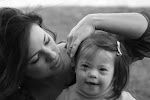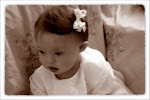I’d been sleeping on the family room couch since I was up most of the night anyway at that point in the pregnancy, and I think I had just fallen asleep when I felt my water break. It wasn’t the gush I’d experienced before—it was a tiny little pop—a whisper, not a roar. I knew that it was amniotic fluid, though, and that we would need to head to the hospital. It was early—I was only 34 weeks along—and Emmy (our 4th) was born just 10 minutes after we got to the hospital, so I woke Chris, called my OB and began getting my things together.
I got really nervous, and my heart was racing. By that point, there was little doubt in my mind that Bridget was not the typical baby we were expecting, although I kept a slim hope that my instincts were wrong. I was anxious, and we rushed to the hospital anticipating a quick delivery. By the time we got there, my blood pressure was high, and my amniotic fluid was low. I tried to make idle chit-chat, but I couldn’t re-direct my thoughts from trying to imagine how I would feel when I was finally able to meet Bridget. I had no idea what to expect, but I knew our lives were going to be forever changed that day. The room was quiet for the most part, and my labor was slow and steady. Bridget arrived over 12 hours after we got to the hospital, on what seemed like the longest day of my life.
We were there through two shift changes and two different on-call doctors with our OB/GYN practice. I had never met the doctor who delivered Bridget. She was straightforward and tactful in explaining what she saw in Bridget. We all noticed right away that there was an enlarged area by Bridget’s umbilical cord, and my heart sunk knowing that she would likely require surgery. Bridget was crying and moving and pink. Despite the strange-looking pouch on her stomach, Bridget looked great—and her apgars were both nines.
The OB gave us some basic information about Bridget’s umbilical area and said that she would need surgery to correct the “omphalocele”--the term for when an organ is inside a pouch outside the abdomen (in her case, it was a small section of the small intestine). She felt that Bridget’s omphalocele was relatively small, and that her surgery would not be as involved as others she had seen. She also said that sometimes omphalocele occurs with other genetic conditions.
As she handed Bridget to me, I remeber the OB saying, “We think your baby displays other characteristics typical of a baby with Down syndrome.” I was looking at Bridget noticing the shape of her little eyes. My own eyes filled with tears, and I was nodding my head in agreement, smiling slightly at Chris.
“I told you,” I said.
"I know,” he replied quietly. “Can you handle this?"
"Yes," I said, "Can you?"
"Yes," he answered as quickly. We both knew there was no looking back, and we would need to figure out how to tell the kids and extended family.
Chris was holding Bridget. He whispered to her, "We've got you, sweetie.” Our nurse overheard him and started crying. She took my hand, said congratulations, and that Bridget was sure to bring us great joy. She said she would send in a neonatologist to discuss Bridget’s diagnosis and to answer any questions we might have.
The neonatologist was kind and thorough. He explained as much as he could about her omphalocele, and what surgery would entail to correct it. He made very few predictions about Bridget’s health and prognosis. He explained the traits commonly associated with a diagnosis of Down syndrome and which of those things he had seen in Bridget. He said that her diagnosis would be confirmed through blood tests. I’ve heard horror stories about some of the things doctors have said to parents with a new Ds diagnosis, and I’m thankful we did not have that experience. This particular doctor took his time, and listened as much as he talked. As he left the room, he said that he sensed our acceptance of the circumstances, and that he thought we would be just fine…
All Feeling Better
12 years ago










No comments:
Post a Comment